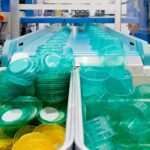Brewing Cell-Derived Coffee in a Lab for More Sustainable Lattes
Cell-derived coffee gets its start in a lab instead of a field, and soon its flavor profile will be comparable enough to meet the rising coffee demand.
An exciting new coffee beverage is on its way, thanks to researchers at the Technical Research Centre of Finland. What makes this coffee different is that researchers brewed it from coffee cells grown in a bioreactor rather than traditionally harvested coffee beans. As temperatures around the globe continue to rise, conventional coffee bean production is expected to decline, all while global consumer demand is increasing. Cell-derived coffee has potential as a sustainable method to keep coffee consumers around the world caffeinated and satisfied.
What is cell culture and how was it used to make coffee?
Cell culture is an important technique that scientists use to replicate a specific type of living tissue, plant or animal, for research purposes. It was developed over a hundred years ago. So far it has led to advances in understanding disease, cancer research, drug development, cellular agriculture, and much more. Cellular agriculture, or the use of cell culture to produce agricultural commodities, has already shown potential in several sectors. For example, tobacco and cloudberry plants have been evaluated for the positive environmental impact of switching from traditional farming techniques to lab-grown plant cells.
In this study, researchers collected coffee plant cells from Coffea arabica seedlings. These cells were then grown in a bioreactor, an instrument used to replicate biological processes, which simulated ideal growing conditions for the cells in liquid media. Under these conditions, the cells replicate until enough mass is produced that it can be filtered, processed, and brewed into coffee. Advantages of this biotechnology include being able to grow and harvest coffee cells year-round, reducing the environmental impact, and creating sustainable production.
But will it taste like Arabica? Will the aroma be the right balance of roasted and nutty?
Comparing cell-derived coffee and conventional coffee
Once the researchers collected and brewed the plant cells, they wanted to measure the appearance, caffeine levels, and sensory properties of the cell-based coffee. They tested unroasted coffee cells as well as roasted coffee cells, which they prepared using three different roasting conditions. The cell-based coffee had a slightly different color profile than conventional coffee, both in the color of the grounds and in the brewed coffee beverage. This is probably caused by changes in the nutrient profile between the lab-grown coffee and harvested beans, but overall the appearance was very similar.
Caffeine levels in the lab-grown coffee cells were found to be different from conventional coffee. While caffeine was present, it was found in much lower amounts than in traditional coffee. This could be a problem for consumers, but thankfully slight changes can be made to the liquid media to provide key enzymes that help boost caffeine production.
RELATED: Science of Sloshing: Why Foam is Important
Likely the most important aspect to the consumer are the sensory properties, which were measured by a panel of 8 people. These tasters found that the cell-derived coffee brewed from unroasted coffee cells did not taste like coffee. They considered the samples to taste more tea-like and with honey notes. The roasted samples were, however, on track with what you would expect from a hot cup of joe. The roasted samples gave off an aroma of burned sugar and a smokey odor, and had comparable bitterness to conventional coffee.
There are some critical differences between the plant coffee and conventional coffee. Many odors described as plant-like and green were only observed in the cell coffee samples. While cell-derived coffee samples also lacked some important coffee odorants, many important ones were still present, such as compounds that produce sweet, chocolate, and caramel scents. One finding was clear though: the stronger roasted cell-derived coffee samples were more similar in composition to conventional coffee.
Brewing sustainability into coffee
Coffee is grown and harvested in a relatively small portion of the globe, called the “coffee belt,” around the equator. It is also typically grown at altitudes from 1300 to 1600 m, the ideal range for preventing pests and infections to the plants. Coffee harvests are strongly impacted by weather events. They are also alarmingly predicted to decrease by half in the next 30 years due to the impacts of climate change. Additionally, coffee production has a relatively high carbon footprint. It produces a similar amount of CO2 emissions per year as entire countries like Denmark or the Philippines.
RELATED: Agricultural Emissions Could Upset Climate Goals
This study served as a proof-of-concept to show that coffee can be brewed from lab-cultured plant cells to potentially overcome sustainability challenges. There are many parameters that can be fine-tuned to improve the appearance, sensory properties, and caffeine levels of cell-derived coffee. Additional steps include processing and optimization, such as fermentation and roasting of coffee plant cells.
The demand for coffee around the globe is rising, and conventional harvesting methods may not be enough to keep up with distribution. Bioreactors have the potential to increase coffee production through cultivation of coffee cells, while also improving the environmental impact of coffee production.
This study was published in the peer-reviewed Journal of Agricultural and Food Chemistry.
References
Aisala, H., Kärkkäinen, E., Jokinen, I., Seppänen-Laakso, T., & Rischer, H. (2023). Proof of concept for cell culture-based coffee. Journal of Agricultural and Food Chemistry, 71(47), 18478–18488. https://doi.org/10.1021/acs.jafc.3c04503
Bestbier, J. (2021, May 5). Cell culture basics: equipment, fundamentals and protocols. Technology Networks Cell Science. https://www.technologynetworks.com/cell-science/articles/cell-culture-basics-equipment-fundamentals-and-protocols-348413


About the Author
Claudia Suzanne Willis is a Junior Research Specialist at a research center for smell and taste science. She is a chemist by training, and an avid reader and baker in her free time. She lives in Philadelphia, PA, with her roommate, cat, and houseplants. Follow Claudia on LinkedIn.




